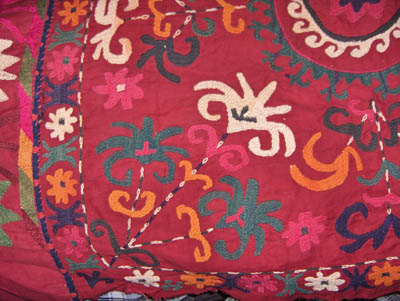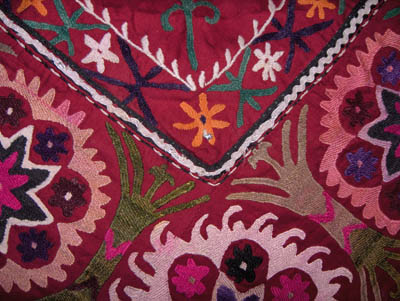embroidery
hi everyone.
i know some of you asked to keep our eyes open for good embroidery.
i was at a rug dealer yesterday and he had a whole bag of a hundred or so pieces
of Uzbeck and Afghan embroidery.
i picked up three and came back today to look at more, and someone had bought
the whole remaining bag of eighty some pieces.
he said he could get thousands. most are not that old, but a few might be. i
didn't get the chance to look through them all.
he said he had some old silk suzani he would bring me.
i will try to take photos and post them for anyone else who is interested.




Posted by Chuck Wagner on 07-19-2006 02:34 PM:
Hi Mike,
Have a look through these two salons; each has quite a few photos of Central
Asian embroidery pieces. Not that many folks in the Turkotek crowd collect them,
but there are a half dozen or so who are real afficianados, myself included.
Silk
In Central Asian Textiles
Turkmen Embroidery
Regards, and happy hunting,
Chuck Wagner
__________________
Chuck Wagner
Posted by R. John Howe on 07-19-2006 03:22 PM:
Mike -
I will shortly put up a mini-salon on Afghan embroidery.
You might want to hold off posting more of it until we have a space where we
can collect it all together.
That way the archive works better for folks trying to reseach it.
But meanwhile, of course, do keep your eyes open.
Regards,
R. John Howe
Posted by Mike McCullough on 07-19-2006 09:42 PM:
sounds good john. will do
Posted by R. John Howe on 07-22-2006 07:48 AM:
Mike -
Steve will know better than I since he follows this sort of embroidery, but
the first three images seem to be of a piece of "Kungrat" embroidery.
The distinction between Kungrat embroidery and that by the Lakais is not clear
to me but in general Kungrat drawing often seems more regular while Lakai has
a visibly "wild" character.
It's likely not that simple and here is a link by Andy Hale and Kate Fitz Gibbon,
two folks who have studied Central Asian textiles seriously and who have published
some remarkable things.
http://www.anahitagallery.com/aharch02.html
Lakai pieces, for some reason, seem to have more cache with collectors (perhaps
because they are more "rural"), but I remember Kate coming to a TM Rug Convention
a few years ago, giving a presentation in which she complained that the Lakai
designation was being applied far too broadly.
And I am not sure, but think that, if the first piece you show has a function
(Andy and Kate indicate that some of these embroideries are "non-functional"),
it is as the edge of a piece that is hung (in the V-like orientation) over a
stack of textiles as a kind of decorative covering.
Regards,
R. John Howe
Posted by Mike McCullough on 07-22-2006 08:57 AM:
hi john.
i went to see the dealer today, and he brought over 100 pieces of afghan embroidery.
i aquired 21 of them at a very reasonable price.
he described them as Lakai.
he said that his grandfather had them since before the revolution, when most
of the older women brought them to him because they needed money for food.
most seem to have some age, and 2 in paticular look as if they might be 19th
century pieces.
then again, i'm not an expert, they just seem to have the look of the 19th century
pieces i have seen in books and on the internet.
they are also the only 2 that appear to have all natural dyes.
most are silk on cotton.
it will take me awhile to post all the photos, as i have alot of pieces. i will
post them in the afghan embroidery salon for all who are interested.
thanks, Mike
Posted by Mike McCullough on 07-22-2006 11:31 AM:
hi everyone.
here are some photos of some afghan embroidery i picked up here in bagram.
most are typically Lakai and some are the more geometric kungrat as described
by Kate Fitz and Andy Hale in the link provided by John Howe. (thanks John)
curiously, a few seem to be a combination of both, made by sewing together fragments.
most are silk on cotton. there is alot of variation in the dyes, and the silk
seems to have been hand dyed by the maker instead of the silk being purchased
pre-dyed.
the vast majority of the dyes appear to be natural, with the exception of the
very brightest pinks and fuschia. those are the only 2 colors i see any hint
of bleeding.
the backing, when present, consists of everything from cheap 70's polyester
to rayon,




rough cotton cloth, and old feed and flour sacks.
i have not seen any machine sewing on any of these pieces.
most seem to be mid-twentieth century, but 2 or 3 may be older.
i would appreciate any comments from anyone with more expertise in this area
than myself. (which is just about everyone)
i have many more photos, but will try to post only the best ones.
hope you enjoy,
Mike
Posted by R. John Howe on 07-22-2006 07:30 PM:
Mike -
It may be that you'ver already taken the photos you will share but if not, it
would be good if you could take at least one overall shot that shows all of
the edges of each piece.
That way we can get some sense of the format.
It is also useful to have approximate dimensions.
Close-up shot ARE useful for embroidery, but its useful to see the piece comprehensively
too.
If you talk to this dealer again you might ask him if puttees are still encountered
and what else he knows about this format.
There are two other formats in this book that puzzle me a bit. There are both
"napkins" and "handkerchiefs." But done in this kind of elaborate emboidery
it seems unlikely that either would be used in their most literal ways. They
must be strictly decorative and not used for wiping either noses or greasy hands.
How could they be cleaned?
You mention that most folks are so poor now that this kind of embroidery doesn't
"come on the map" of their lives. Is this true also of such occasions as weddings?
Some of these items seem (nearly always?) to have been reserved for special
occasions.
Regards,
R. John Howe
Posted by Mike McCullough on 07-22-2006 09:40 PM:
hi john.
most of these pieces seem to have been used for daily use and some are very
dirty and still have stains. they all need a thorough cleaning. all of these
pieces are much to large to be napkins or handkerchiefs.
i will try to concentrate on one piece daily, giving demensions and observations.
i have also done some research over the internet on the function of each piece,
and will include that with each series of photos.
thanks,
Mike
Posted by Chuck Wagner on 07-22-2006 10:34 PM:
Hi Mike,
Here's an example of an interesting type of embroidery found in Turkoman Afghanistan.
This is a childs bib (I'm not sure whether it was originally part of a larger
garment or an independant piece) with some nice detail work. It's about 22 inches
across, as I recall:


Regards,
Chuck Wagner
__________________
Chuck Wagner
Posted by Mike McCullough on 07-23-2006 09:27 AM:
hi everyone,
this is one of the Lakai embroideries i picked up in afghanistan.
the diagonal measurements are 46 by 46 inches.
it is silk on cotton and appears to be unfinished.
as you can see it has a 2 1/2 inch crocheted border with the ends tied in a
2 1/2 inch fringe. the fringe originally had bright colored tufts with glass
beads, but most have fallen off or come undone.
there is also a very tiny silver bead in the small orange flower in the vee.
the backing is scraps of four different kinds of cotton cloth.
it is completely hand sewn.
there are some drawings of patterns with silk embroidery started, but never
completed.
i have read that some pieces this size were used to wrap babies in, and the
designs were to protect the infant from evil.
i only wonder what this would have looked like had it finished as a complete
square. it would have had a diagonal measurement of over 60 inches.
i have been told by the locals that these are simply not made anymore.
if i had to guess the age, i would say the cloth backing is 1960's




Posted by Steve Price on 07-23-2006 10:09 AM:
Hi Mike
Protection against the evil eye, the actions of which are often a response to
envy, is a common theme throughout Asia and around the Mediterranean. Bright,
irregular patterns are thought to protect by distracting the evil eye.
It's very bad manners in some cultures to express admiration for a baby except
in elliptical phrases, since that would attract the evil eye to it. And, in
much of Asia, it's bad manners to give anybody something without wrapping it
- even a loaf of bread - because it might incite the envy of others.
Regards
Steve Price
Posted by Mike McCullough on 07-23-2006 11:47 AM:
hi Steve
everytime i by a rug, it is folded as tightly as possible, wrapped up in a cotton
scarf, and put in a thick plastic bag, for that same reason.
Posted by Mike McCullough on 07-28-2006 10:13 PM:
hi everyone.
this is another very nice Lakai embroidery i found here in afghanistan.
it is about 9 inches wide and has a small crochet border.
each of the bands is 28 inches long.
very colerful and nicely drawn.




Posted by Lisa Bernard on 08-26-2006 06:50 PM:
afghan patterns
i came here looking for common motifs or patterns in afghan textiles--i'm a
knitter who's currently reading "the kite runner," and i thought it might be
a nice tie-in to my reading to knit something for afghans for afghans (http://www.afghansforafghans.org/). i can't use any religious
or national symbols, nor representational images (e.g., faces, animals).
i'm wondering if you have any suggestions of sort of iconic afghani patterns
that recur in traditional designs--what does the angular spiral indicate that's
in several of the photos i'm seeing here? also, i'm seeing a lot of color range
variation here--very bright in some but deep colors in others. is there a reason
behind those choices--ethnic or regional or for certain occasions?
incidentally, the second photo in mike's post reminds me very much of one of
my favorites of my father's pieces--i never knew these were afghan pieces! how
cool.
anyway, any advice anyone might have for designing a pattern--color and the
pattern itself--i'd be interested in hearing it. would love for it to be appropriate
to the afghans for afghans project and to "the kite runner" if at all possible,
though of course the former is far more important than the latter. and if i'm
in the wrong forum, i apologize--it's my first foray into turkotek forums!
thanks all,
lisa
(dad, did you add that smiley of einstein sticking his tongue out?? geez.)
__________________
Steve's daughter
Posted by Steve Price on 08-26-2006 10:33 PM:
Hi Lisa
We really like people to use their full names when they register and post -
you can add your last name through the button marked "User CP" on the left side
of the screen just below the introductory paragraph. Please.
The "ferris wheel" is said to represent the sun; nearly anything that includes
a cross in it (with embellished ends) is said to represent a tree of life. I
don't know whether that's right, but it's plausible enough.

Dad

















